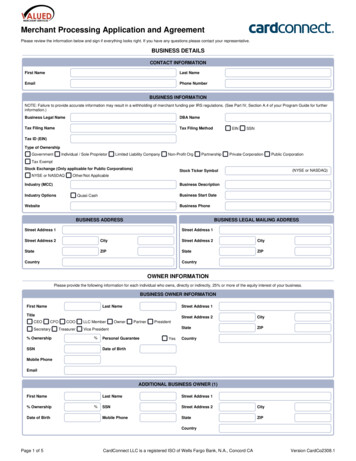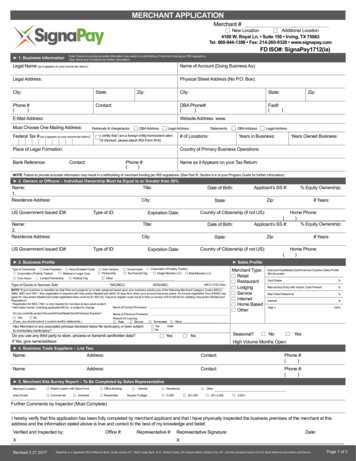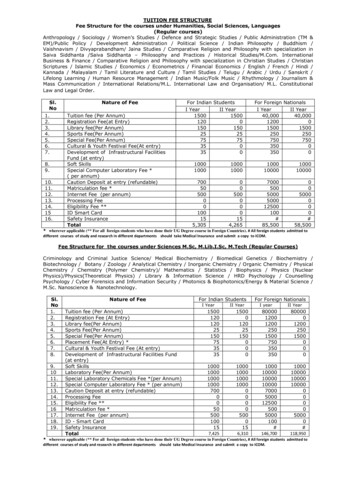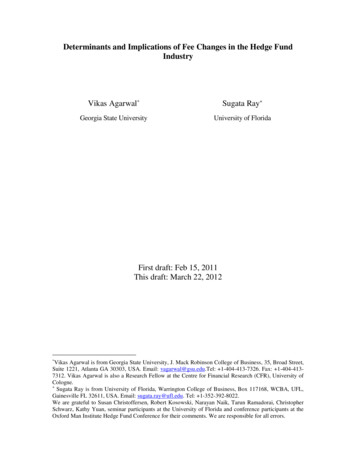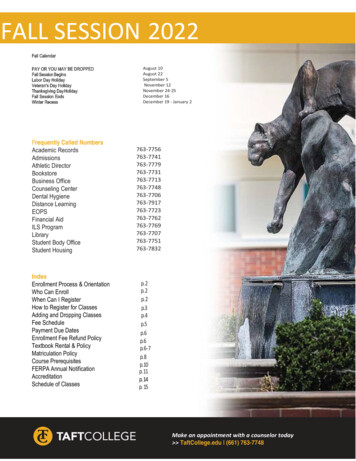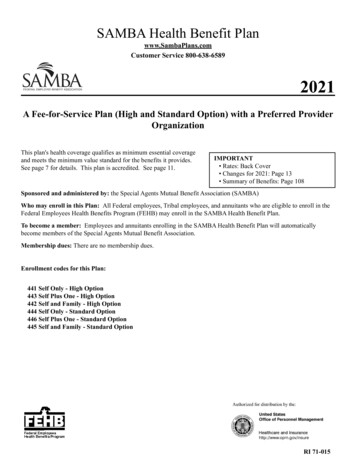
Transcription
SAMBA Health Benefit Planwww.SambaPlans.comCustomer Service 800-638-65892021A Fee-for-Service Plan (High and Standard Option) with a Preferred ProviderOrganizationThis plan's health coverage qualifies as minimum essential coverageand meets the minimum value standard for the benefits it provides.See page 7 for details. This plan is accredited. See page 11.IMPORTANT Rates: Back Cover Changes for 2021: Page 13 Summary of Benefits: Page 108Sponsored and administered by: the Special Agents Mutual Benefit Association (SAMBA)Who may enroll in this Plan: All Federal employees, Tribal employees, and annuitants who are eligible to enroll in theFederal Employees Health Benefits Program (FEHB) may enroll in the SAMBA Health Benefit Plan.To become a member: Employees and annuitants enrolling in the SAMBA Health Benefit Plan will automaticallybecome members of the Special Agents Mutual Benefit Association.Membership dues: There are no membership dues.Enrollment codes for this Plan:441 Self Only - High Option443 Self Plus One - High Option442 Self and Family - High Option444 Self Only - Standard Option446 Self Plus One - Standard Option445 Self and Family - Standard OptionRI 71-015
Important Notice from SAMBA AboutOur Prescription Drug Coverage and MedicareThe Office of Personnel Management (OPM) has determined that the SAMBA Health Benefit Plan's prescription drugcoverage is, on average, expected to pay out as much as the standard Medicare prescription drug coverage will pay for allplan participants and is considered Creditable Coverage. This means you do not need to enroll in Medicare Part D and payextra for prescription drug coverage. If you decide to enroll in Medicare Part D later, you will not have to pay a penalty forlate enrollment as long as you keep your FEHB coverage.However, if you choose to enroll in Medicare Part D, you can keep your FEHB coverage and your FEHB plan willcoordinate benefits with Medicare.Remember: If you are an annuitant and you cancel your FEHB coverage, you may not re-enroll in the FEHB Program.Please be advisedIf you lose or drop your FEHB coverage and go 63 days or longer without prescription drug coverage that is at least as goodas Medicare's prescription drug coverage, your monthly Medicare Part D premium will go up at least 1% per month for everymonth that you did not have that coverage. For example, if you go 19 months without Medicare Part D prescription drugcoverage, your premium will always be at least 19 percent higher than what many other people pay. You will have to pay thishigher premium as long as you have Medicare prescription drug coverage. In addition, you may have to wait until the nextAnnual Coordinated Election Period (October 15 through December 7) to enroll in Medicare Part D.Medicare’s Low Income BenefitsFor people with limited income and resources, extra help paying for a Medicare prescription drug plan is available.Information regarding this program is available through the Social Security Administration (SSA) online atwww.socialsecurity.gov, or call the SSA at 800-772-1213 (TTY: 800-325-0778).You can get more information about Medicare prescription drug plans and the coverage offered in your area from theseplaces: Visit www.medicare.gov for personalized help; Call 800-MEDICARE (800-633-4227), (TTY: 877-486-2048)
Table of ContentsIntroduction .3Plain Language .3Stop Health Care Fraud! .3Discrimination is Against the Law .4Preventing Medical Mistakes .5FEHB Facts .7Coverage information .7 No pre-existing condition limitation.7 Minimum essential coverage .7 Minimum value standard .7 Where you can get information about enrolling in the FEHB Program .7 Types of coverage available for you and your family .7 Family Member Coverage .8 Children’s Equity Act .8 When benefits and premiums start .9 When you retire .9When you lose benefits .9 When FEHB coverage ends .9 Upon divorce .10 Temporary Continuation of Coverage (TCC) .10 Converting to individual Coverage.10 Health Insurance Marketplace .10Section 1. How This Plan Works .11General features of our High and Standard Options .11We have a Preferred Provider Organization (PPO) .11How we pay providers .11Your rights and responsibilities .12Your medical and claims records are confidential .12Section 2. Changes for 2021 .13Changes to both our High and Standard Options .13Changes to our High Option only .13Changes to our Standard Option only .13Clarifications .13Section 3. How You Get Care .14Identification cards .14Where you get covered care .14 Covered providers.14 Covered facilities .15 Transitional care .16 If you are hospitalized when your enrollment begins .16You need prior Plan approval for certain services .16 Inpatient hospital admission .16 Other services .17 Radiology/Imaging procedures.17 Applied Behavior Analysis (ABA) therapy .18How to request precertification for an admission or get prior authorization for Other services .18 Non-urgent care claims .18 Urgent care claims .18 Concurrent care claims .19 The Federal Flexible Spending Account Program – FSAFEDS.19 Emergency inpatient admission .192021 SAMBA Health Benefit Plan1Table of Contents
Maternity care .19 If your hospital stay needs to be extended .20 If your treatment needs to be extended .20If you disagree with our pre-service claim decision .20 To reconsider a non-urgent care claim .20 To reconsider an urgent care claim .20 To file an appeal with OPM .20Section 4. Your Costs for Covered Services .21Cost-sharing .21Copayment .21Deductible .21Coinsurance .22If your provider routinely waives your cost .22Waivers .22Differences between our allowance and the bill .22Your catastrophic protection out-of-pocket maximum for deductibles, coinsurance, and copayments .23Carryover .24If we overpay you .25When Government facilities bill us .25Section 5. High and Standard Option Benefits .26Non-FEHB Benefits Available to Plan Members.85Section 6. General Exclusions – Services, Drugs and Supplies We Don’t Cover .86Section 7. Filing a Claim for Covered Services .88Section 8. The Disputed Claims Process.90Section 9. Coordinating Benefits with Medicare and Other Coverage .92When you have other health coverage .92 TRICARE and CHAMPVA .92 Workers' Compensation .92 Medicaid .92When other Government agencies are responsible for your care .93When others are responsible for injuries.93When you have Federal Employees Dental and Vision Insurance Plan (FEDVIP) .94Clinical Trials .94When you have Medicare .95 The Original Medicare Plan (Part A or Part B).95 Tell us about your Medicare coverage .96 Private Contract with your physician .96 Medicare Advantage (Part C) .96 Medicare prescription drug coverage (Part D) .97When you are age 65 or over and do not have Medicare .99When you have the original Medicare Plan (Part A, Part B, or both) .100Section 10. Definitions of Terms We Use in This Brochure .101Index.107Summary of Benefits for the High Option of the SAMBA Health Benefit Plan - 2021 .108Summary of Benefits for the Standard Option of the SAMBA Health Benefit Plan - 2021 .1092021 Rate Information for the SAMBA Health Benefit Plan .1102021 SAMBA Health Benefit Plan2Table of Contents
IntroductionThis brochure describes the benefits of the SAMBA Health Benefit Plan under SAMBA's contract (CS 1074) with the United StatesOffice of Personnel Management, as authorized by the Federal Employees Health Benefits law. Customer service may be reached at800-638-6589 or 301-984-1440 (for TTY, use 301-984-4155) or through our website: www.SambaPlans.com. The address for theSAMBA Health Benefit Plan administrative offices is:SAMBA Health Benefit Plan11301 Old Georgetown RoadRockville, MD 20852-2800This brochure is the official statement of benefits. No verbal statement can modify or otherwise affect the benefits, limitations, andexclusions of this brochure. It is your responsibility to be informed about your health benefits.If you are enrolled in this Plan, you are entitled to the benefits described in this brochure. If you are enrolled in Self Plus One or Selfand Family coverage, each eligible family member is also entitled to these benefits. You do not have a right to benefits that wereavailable before January 1, 2021, unless those benefits are also shown in this brochure.OPM negotiates benefits and rates with each plan annually. Benefit changes are effective January 1, 2021, and changes aresummarized on page 13. Rates are shown at the end of this brochure.Plain LanguageAll FEHB brochures are written in plain language to make them easy to understand. Here are some examples: Except for necessary technical terms, we use common words. For instance, “you” means the enrollee and each covered familymember, “we” or "us" means the SAMBA Health Benefit Plan. We limit acronyms to ones you know. FEHB is the Federal Employees Health Benefits Program. OPM is the United States Officeof Personnel Management. If we use others, we tell you what they mean. Our brochure and other FEHB plans’ brochures have the same format and similar descriptions to help you compare plans.Stop Health Care Fraud!Fraud increases the cost of health care for everyone and increases your Federal Employees Health Benefits Program premium.OPM’s Office of the Inspector General investigates all allegations of fraud, waste, and abuse in the FEHB Program regardless of theagency that employs you or from which you retired.Protect Yourself From Fraud – Here are some things that you can do to prevent fraud: Do not give your plan identification (ID) number over the phone or to people you do not know, except for your health care provider,authorized health benefits plan, or OPM representative. Let only the appropriate medical professionals review your medical record or recommend services. Avoid using health care providers who say that an item or service is not usually covered, but they know how to bill us to get it paid. Carefully review explanations of benefits (EOBs) statements that you receive from us. Periodically review your claim history for accuracy to ensure we have not been billed for services you did not receive. Do not ask your doctor to make false entries on certificates, bills, or records in order to get us to pay for an item or service. If you suspect that a provider has charged you for services you did not receive, billed you twice for the same service, ormisrepresented any information, do the following:- Call the provider and ask for an explanation. There may be an error.- If the provider does not resolve the matter, call us at 800-638-6589 or 301-984-1440 (for TTY, use 301-984-4155) and explainthe situation.- If we do not resolve the issue:2021 SAMBA Health Benefit Plan3Introduction/Plain Language/Advisory
CALL - THE HEALTH CARE FRAUD HOTLINE877-499-7295OR go to t-fraud-waste-or-abuse/complaint-form/The online reporting form is the desired method of reporting fraud in order to ensure accuracy, and a quicker response time.You can also write to:United States Office of Personnel ManagementOffice of the Inspector General Fraud Hotline1900 E Street NW Room 6400Washington, DC 20415-1100 Do not maintain as a family member on your policy:- Your former spouse after a divorce decree or annulment is final (even if a court order stipulates otherwise); or- Your child age 26 or over (unless he/she was disabled and incapable of self -support prior to age 26).A carrier may request that an enrollee verify the eligibility of any or all Family members listed as covered under the enrollee'sFEHB enrollment. If you have any questions about the eligibility of a dependent, check with your personnel office if you are employed, with yourretirement office (such as OPM) if you are retired, or with the National Finance Center if you are enrolled under TemporaryContinuation of Coverage (TCC). Fraud or intentional misrepresentation of material fact is prohibited under the Plan. You can be prosecuted for fraud and youragency may take action against you. Examples of fraud include falsifying a claim to obtain FEHB benefits, trying to or obtainingservices or coverage for yourself or for someone who is not eligible for coverage, or enrolling in the Plan when you are no longereligible. If your enrollment continues after you are no longer eligible for coverage (i.e., you have separated from Federal service) andpremiums are not paid, you will be responsible for all benefits paid during the period in which premiums were not paid. You maybe billed by your provider for services received. You may be prosecuted for fraud for knowingly using health insurance benefits forwhich you have not paid premiums. It is your responsibility to know when you or a family member is no longer eligible to use yourhealth insurance coverage.Discrimination is Against the LawThe SAMBA Health Benefit Plan complies with applicable Federal civil rights laws, including Title VII of the Civil Rights Act of1964 and Section 1557 of the Affordable Care Act.You can also file a civil rights complaint with the Office of Personnel Management by mail at:Office of Personnel ManagementHealthcare and InsuranceFederal Employee Insurance OperationsAttention: Assistant Director FEIO1900 E Street NW, Suite 3400-SWashington, D.C. 20415-36102021 SAMBA Health Benefit Plan4Introduction/Plain Language/Advisory
Preventing Medical MistakesMedical mistakes continue to be a significant cause of preventable deaths within the United States. While death is the most tragicoutcome, medical mistakes cause other problems such as permanent disabilities, extended hospital stays, longer recoveries, and evenadditional treatments. Medical mistakes and their consequences also add significantly to the overall cost of healthcare. Hospitals andhealthcare providers are being held accountable for the quality of care and reduction in medical mistakes by their accrediting bodies.You can also improve the quality and safety of your own health care and that of your family members by learning more about andunderstanding your risks. Take these simple steps:1. Ask questions if you have doubts or concerns. Ask questions and make sure you understand the answers. Choose a doctor with whom you feel comfortable talking. Take a relative or friend with you to help you take notes, ask questions and understand answers.2. Keep and bring a list of all the medications you take. Bring the actual medications or give your doctor and pharmacist a list of all the medications and dosage that you take, includingnon-prescription (over-the-counter) medications and nutritional supplements. Tell your doctor and pharmacist about any drug, food, and other allergies you have, such as latex. Ask about any risks or side effects of the medication and what to avoid while taking it. Be sure to write down what your doctor orpharmacist says. Make sure your medication is what the doctor ordered. Ask the pharmacist about your medicine if it looks different than youexpected. Read the label and patient package insert when you get your medication, including all warnings and instructions. Know how to use your medication. Especially note the times and conditions when your medication should and should not be taken. Contact your doctor or pharmacist if you have any questions. Understanding both the generic and brand names of your medication. This helps ensure you do not receive double dosing fromtaking both a generic and a brand. It also helps prevent you from taking a medication to which you are allergic.3. Get the results of any test or procedure. Ask when and how you will get the results of tests or procedures. Will it be in person, by phone, mail, through the Plan orProvider's portal? Don’t assume the results are fine if you do not get them when expected. Contact your healthcare provider and ask for your results. Ask what the results mean for your care.4. Talk to your doctor about which hospital or clinic is best for your health needs. Ask your doctor about which hospital or clinic has the best care and results for your condition if you have more than one hospital orclinic to choose from to get the health care you need. Be sure you understand the instructions you get about follow-up care when you leave the hospital or clinic.5. Make sure you understand what will happen if you need surgery. Make sure you, your doctor, and your surgeon all agree on exactly what will be done during the operation. Ask your doctor, “Who will manage my care when I am in the hospital?” Ask your surgeon:- "Exactly what will you be doing?"- "About how long will it take?"- "What will happen after surgery?"2021 SAMBA Health Benefit Plan5Introduction/Plain Language/Advisory
- "How can I expect to feel during recovery?" Tell the surgeon, anesthesiologist, and nurses about any allergies, bad reactions to anesthesia, and any medications or nutritionalsupplements you are taking.Patient Safety LinksFor more information on patient safety, please visit: www.jointcommission.org/speakup.aspx. The Joint Commission's Speak Up patient safety program. www.jointcommission.org/topics/patient safety.aspx. The Joint Commission helps health care organizations to improve the qualityand safety of the care they deliver. www.ahrq.gov/patients-consumers/. The Agency for Healthcare Research and Quality makes available a wide-ranging list of topicsnot only to inform consumers about patient safety but to help choose quality health care providers and improve the quality of careyou receive. www.bemedwise.org. The National Council on Patient Information and Education is dedicated to improving communication aboutthe safe, appropriate use of medications. www.
SAMBA Health Benefit Plan www.SambaPlans.com Customer Service 800-638-6589 2021 A Fee-for-Service Plan (High and Standard Option) with a Preferred Provider . FEHB is the Federal Employees Health Benefits Program. OPM is the United States Office of Personnel Management. If we use others, we tell you what they mean.
